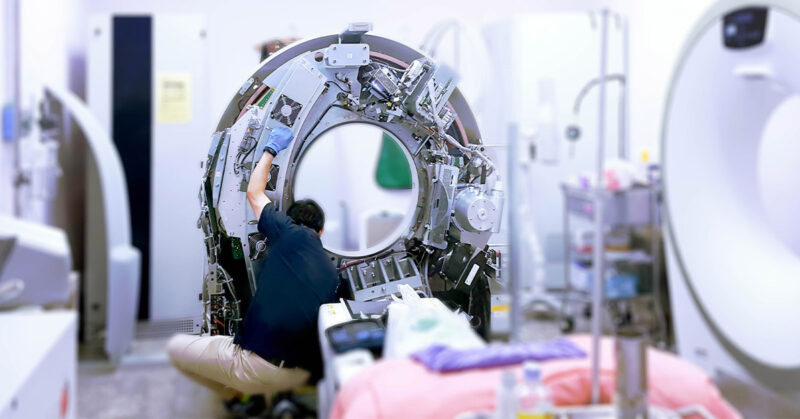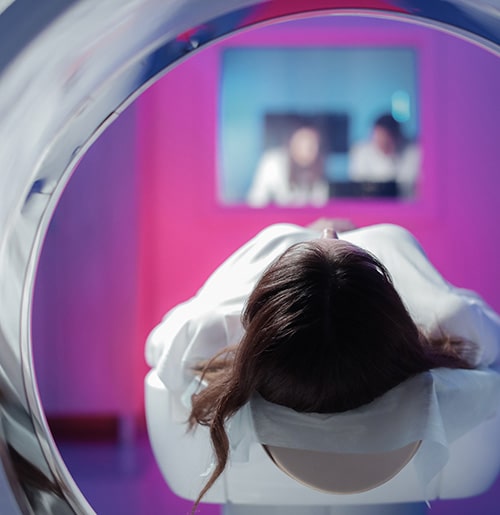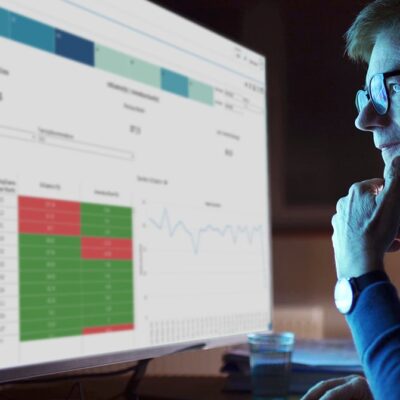
Healthcare’s Next Transition: From Proactive to Predictive Analytics
Unplanned downtime is one of the biggest pain points for imaging departments, other caregivers, and their patients. Unplanned downtime has been and continues to be highly disruptive, creating chain reactions of delays and inefficiencies, frustrated patients, and increased costs. Due to outdated or disconnected technologies, imaging departments lacked visibility and predictability into device performance, asset utilization, and other key performance indicators to make informed, cost-effective decisions.
Fast-forward to today where artificial intelligence and machine learning can provide “smart maintenance” with proactive alerts and predictive notifications for connected medical imaging devices. These technologies are changing how imaging departments and their service providers approach their operations. These analytics can provide operational, financial, and clinical insights to significantly reduce unplanned downtime, maximize patient throughput, and gain a healthy return on investment. This healthcare business intelligence significantly reduces unplanned downtime and sets the imaging department and its service provider up for success.
The Benefit of Proactive Analytics
Few imaging departments and their service providers use proactive analytics today to deliver active monitoring and real-time data analytics from their connected medical imaging devices. Proactive data analytics can significantly help imaging departments and their service providers to maximize uptime and utilization. By sending alerts before a medical imaging system’s issue escalates and becomes critical, the service provider can respond proactively and avert a serious interruption in scanning for the imaging department.
Current advanced imaging modalities are equipped with sensors and connectivity enabling proactive capabilities such as system alerts to call attention to potential issues and remote monitoring. This has reduced the need for service providers to be onsite to troubleshoot, allowing their staff to be more efficient. Now, there are virtual eyes on the equipment 24 hours a day, seven days a week. At any point in time, an engineer can login to a system from anywhere in the country to monitor its performance.
How Proactive Analytics Are Used
Proactive analytics can help imaging departments and their service providers maximize efficiency and utilization while reducing service costs. Without data analytics many healthcare organizations fly blind when it comes to managing costly fixed assets such as CT scanners and MRIs. Scheduling issues or extended downtime can result in idle machines, negatively impacting staff productivity, patient care and satisfaction, and department revenues. According to AuntMinnie.com, imaging system outages account for almost $300,000 in lost revenue annually for a medium-sized facility. This doesn’t factor in the secondary effects such as rescheduled procedures, delayed surgeries, and postponed discharges. The imaging department expects its medical imaging devices to be up and running at optimum performance. The more proactive the service provider can be, the more productive the imaging department can be.

Proactive analytics can also help a service provider better understand parts inventory requirements by facility and department. Service analytics gathered from tracking data such as parts replacement rates can ensure service providers have key parts available when needed. Service providers can also use these analytics to manage supplier lead times for critical parts, resulting in less unplanned downtime and better cost control.
An imaging department and its service provider can also use proactive analytics to analyze logs and perform a root cause analysis when needed. For Example, real-time environmental monitoring for an MRI can provide alerts for compressor power, room temperature and humidity, and chiller water temperature. An automatic alert notifies the service provider that there’s an issue with magnet pressure. The data shows the compressor is off and the helium isn’t being cooled. These analytics allow a service engineer to evaluate and diagnose the issue and address it proactively, before the MRI shuts down.
The Benefit of Predictive Analytics
Using artificial intelligence and machine learning, predictive analytics use historical and current data, past trends, and patterns to determine the likelihood of those patterns or trends occurring again, such as a service event.
Predictive analytics applies algorithms and machine learning techniques to data to make future predictions in certain areas such as hospital bed capacity, patient adverse events, patient scheduling needs, and maintenance requirements on clinical assets. Applying data science at this level enables healthcare organizations to be more proactive in their decisions.
How Predictive Analytics Are Used
Many imaging organizations still rely purely on historical data to solve challenges, which keeps them in a reactive position and leads to a continuous loop of stagnation. Leveraging artificial intelligence and machine learning results in prescriptive, actionable solutions. Predictive analytics can help healthcare imaging departments and their service providers in several ways.
Predictive service analytics can reduce the length of downtime, enabling imaging departments to reduce costs and workflow disruption, while also improving their operational efficiency.
Clinically, predictive analytics can improve patient outcomes by identifying patients who are at higher risk of developing certain conditions or diseases. This allows imaging departments to provide earlier and more targeted interventions that can improve patient outcomes. Predictive analytics can provide radiologists with valuable insights into patient conditions, allowing them to make more informed decisions about diagnosis and treatment and avoid unnecessary tests.

In an interview with Becker’s Hospital Review, Brad Reimer, CIO of Sanford Health, in Sioux Falls, S.D., stated his organization is investing in areas like data analytics and AI to support their workforce needs and improve clinical outcomes. The organization is leveraging predictive analytics to make sure they have the right people in the right place at the right time to build a more resilient and sustainable workforce, bridge the workforce shortage gap, and reduce clinician burnout.
Predictive analytics allow an imaging department and its service organization to anticipate when a machine will be down outside of its regular maintenance schedule due to a component failure. Anomaly detection is used to identify early warning trends, providing actionable insights. For Example, based on historical data, predictive analytics can often predict a CT tube failure more than a week in advance. This allows the imaging department to schedule overnight maintenance with a vendor or shift patients to another CT system/site to minimize patient impact and loss of revenue. Predictive analytics also helps the health system in the event a part is not available locally. With the pandemic-driven disruption in supply chains, it is more common for a part to take three or more days to be delivered. These analytics can help service providers minimize parts usage, shipping fees, and labor expenses.
With predictive data analytics, hospitals and medical practices can predict future scheduling needs and share scheduling information to optimize facility and clinician capacity. Real-time information enables them to book patient appointments strategically. This allows an imaging department to schedule patients with the same types of exams close together and schedule exams that have a higher variability, such as a patient with claustrophobia, later in the day to minimize disruptions to the schedule. Maximizing scheduling capacity improves patient access and care quality, the ROI for fixed assets such as medical imaging devices, and ultimately revenue.
A clinical engineering department that needs to optimize service costs for a fleet of CT machines and other fixed assets can apply predictive analytics to better plan parts procurement, rather than being reactive and purchasing them immediately following an unexpected failure. This enables an organization to reduce spend and maximize operational efficiency.
As imaging organizations and their service partners continue to collect more data, they will start to make more predictions, benchmark results, and develop best practices. Ultimately, these actions will lead to a “smarter” organization which operates more efficiently and is easier to work with.
The Future of Predictive Analytics
Predictive analytics will soon become the standard within healthcare operations. Therefore, it’s crucial that as imaging departments build their analytics capabilities, they create a sound data analytics strategy that includes data governance. With the right data analytics strategy, imaging organizations can combine different sources of data to reveal actionable, proactive insights, and use this information to inform their future strategies.

There is a lot of untapped potential for data analytics in healthcare. Data intelligence provides a complete view of everything from a patient’s medical record to how a hospital’s medical imaging devices are performing. Where traditional methods fail, data intelligence offers insights on how to optimize workflows, care quality, costs, and more. Five ways data intelligence is advancing healthcare are:
- Analyzing large amounts of information
- Offering pure visibility into underlying data to create a complete picture
- Supporting clinical, operational, and business objectives
- Helping organizations become more intelligent over time
- Ensuring sensitive patient data remains secure
Advances in healthcare data analytics are expected to drive a smart hospital transformation in the industry. Pressure to reduce rising healthcare costs, growth of advanced analytics, and growing patient demand for personalized care are the key factors driving the growth. The global healthcare predictive analytics market size was valued at $9.3 billion in 2021 and is expected to grow at a compounded annual growth rate of 24.5 percent from 2022 to 2030.
Imaging organizations that are saddled with legacy systems that were not built to talk to one another will need to solve interoperability challenges and invest in data analytics solutions, driven by artificial intelligence and machine learning. With a strong data analytics foundation, imaging departments will have a more complete vision of their organization. Data analytics can provide organizations with more targeted, in-depth data, analysis, and actionable insights as they pursue their goals. The imaging department’s ability to leverage this healthcare business intelligence is vital to their success. Investments made today in healthcare data analytics will give organizations a stronger competitive edge in the near future.
Explore the Possibilities
With more than 1 million exams examined each day by Glassbeam solutions, see how top organizations are transforming their log data into impactful insights.
Transform Your Healthcare Operations
See how to gain deeper, clearer insight from your machine data to elevate business intelligence and to improve your operational uptime, utilization, and efficiency.